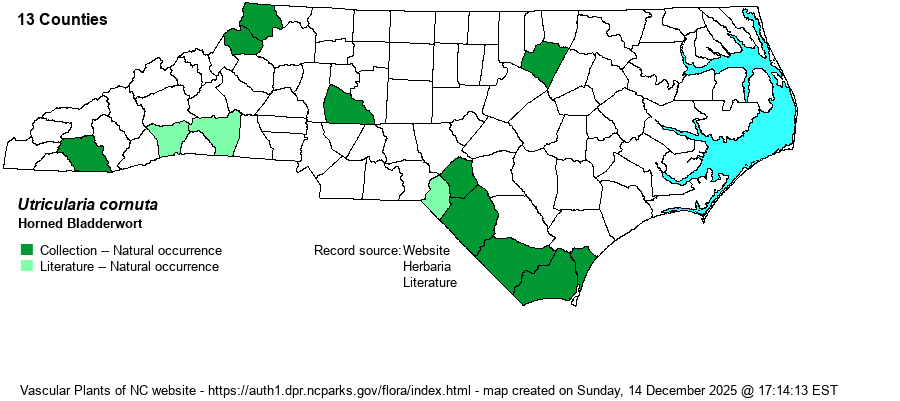| Author | Michaux | |
| Distribution | Widely scattered across the state, but mainly found in the southwestern part of the Coastal Plain, near the SC line. Found at two flatrock sites in the Piedmont, plus a third without a known habitat. Found in a few bogs/fens in the Mountains and a Macon County site in a cleared bottomland. Known from just 13 counties in the state. Specimens from Scotland County (DUKE) and Dare County (NCSC) are misidentified, but there is a recent iNaturalist photo set (in 2020) from Scotland County.
This is primarily a Northern species of bladderwort, even though it ranges south to the Gulf Coast across all of FL and west to central TX. It is quite widespread across Canada and is found in most counties south to RI, CT, NY and MN. Between these states and the Gulf Coast, it is very spotty and scarce, and VA still lacks a record. | |
| Abundance | Though uncommon to locally numerous (in dense colonies) at limesink ponds in the Boiling Spring Lakes area of Brunswick County, outside of that area it is very rare in the state. Deservedly so, it is a State Threatened species. | |
| Habitat | This species is more particular in its habitats than most bladderworts, not being found in the typical shallow water of lake and pond margins and wet ditches, but most sites are fairly pristine, away from the influence of man. It the Coastal Plain it favors natural limesink ponds, but it has been found at the margins of a Carolina bay lake and a Carolina bay pool/savanna. In the Piedmont it is restricted to seeps and pools on granitic flatrocks. In the mountains it has been found mainly in bogs and fens. Some sites are over mafic or calcareous rocks, which yield circumneutral soil; but other sites are not and thus occur in acidic waters/soil. In a few places in Brunswick, it can grow with the similar U. juncea. | |
| Phenology | Blooms from June to September, quite a bit earlier than does U. juncea where both occur together. Fruits shortly after flowering. | |
| Identification | This is one of the more striking species of bladderworts in the state, having a bright yellow to often a more golden-yellow color to the fairly large flowers. In this species the small leaves are not an identification feature, so it is the flowers that are the key -- they grow on a thin stalk up to 10-12 inches high, and a handful of flowers are in bloom at the same time. Each flower, about 2/3-inch long, has a slender spur that is curved downward, almost "tilting" the flower diagonally upward. This flower shape and orientation is found only in U. juncea. This latter species has more medium yellow flowers (though both can be the same color), but they are smaller (about 1/2-inch across), on a shorter stalk growing to about 8 inches tall. U. cornuta has a denser cluster of flowers, whereas in U. juncea the flowers are farther spaced out on the stem. The flower stalk of U. cornuta is mostly yellow-green, whereas that of U. juncea is purplish-green. As mentioned above, U. cornuta blooms before U. juncea, often by a few weeks or a month, at the same location. Most biologists are not going to be able to find a new location for this species, though thankfully some are in protected sites and nearly all grow in "natural areas". | |
| Taxonomic Comments | None
| |
| Other Common Name(s) | None | |
| State Rank | S1S2 | |
| Global Rank | G5 | |
| State Status | T | |
| US Status | | |
| USACE-agcp | OBL link |
| USACE-emp | OBL link |

